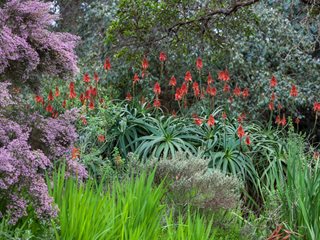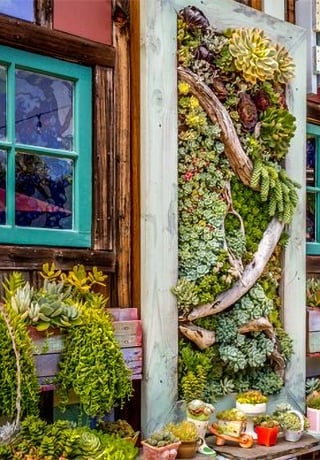Growing Aloes
Learn about growing and caring for aloe plants, including Aloe vera, Aloe arborescens and othersWhen you think of Aloe, chances are the first thing that comes to mind is Aloe vera. However, there are over 600 species ranging in size from a few inches to 20-foot aloe trees. These evergreen succulents have fleshy leaves and are native to arid, semi-arid, and tropical regions. Their sensitivity to frost limits garden usage to frost-free zones for the most part, but many can also be grown in containers and moved to a warmer location over winter. Most Aloe bloom in winter, attracting hummingbirds to their bright tubular flowers when little else is available.
On this page: Aloe Basics | Planting Instructions | Care | Aloe Vera | Types of Aloe | Design Tips | Aloe vs. Agave
- ALOE PLANT BASICS
- PLANTING ALOE
- ALOE PLANT CARE
- ALOE VERA
- TYPES OF ALOE PLANTS
- DESIGN TIPS FOR USING ALOES
- ALOE VS. AGAVE
ALOE BASICS
Zones:
Most aloes can be grown outdoors in Zones 9-11. There are a few varieties that are hardy to Zone 7 or 8, and some heat-tolerant to Zone 12. The ideal growing temperature for most aloes is 40° to 90°F, but many will do fine with brief periods as low as 25° or up to 100°F.
Height/Spread:
Varieties range from small plants 2 to 4 inches tall and wide to tree types at 20 feet or more.
Exposure:
Aloes need full sun of at least 6 hours a day. Many varieties will benefit from partial afternoon shade, especially in desert climates. Full sun encourages flowering, as well as boosts the red and orange tones in the leaves. Ample sunshine also makes them less susceptible to pests, diseases, and rot from overwatering.
Bloom time:
Most Aloe bloom mid-winter; some in summer and late autumn. However, you can find species that bloom just about any time of year. If year-round temperatures are mild enough, some may bloom periodically throughout the year.
Color and characteristics:
Aloe have tubular flowers that bloom in clusters on tall stalks that shoot up above the foliage. Flowers are mainly shades of orange, red or yellow, and occasionally cream, pink, green or white. Their sword-shaped leaves can be straight or curved and have serrated edges, or “teeth.” When stressed by cold, drought, too much sun, or even extremely poor soil, leaves may develop red or orange coloring along the edges or throughout.
ALOE ALTERNATIVE:
Love the dramatic blooms of aloe, but can’t grow them? Get this look with red hot poker, a perennial with grass-like foliage and tall yellow, red or orange spiky flowers. The Pyromania™ series will bring a unique drama to your landscape.
- Zones: 5 - 9
- Blooms: Summer
- Exposure: Full sun
- Height: 24 to 54 inches
PLANTING ALOE
When to plant:
Spring is the best time to transplant aloes because they do most of their growing in the summer.
Where to plant:
Plant aloes where they will receive at least 6 hours of sunlight per day and in well-drained soil to prevent rot. If grown in a borderline zone where temperatures may dip, plant them in a location that provides some insulation and protection from cold air or wind. Small and medium varieties do well in containers with appropriate drainage.
How to plant:
When transplanting aloe, dig the planting hole wide, but not too deep. Remove the plant from the container, keeping the root ball intact. Place the plant in the hole so that the base of the plant is at ground level, and spread the roots out. Backfill the hole with soil and water to settle the plant in. Stake larger plants as needed.
ALOE PLANT CARE
Pruning/Maintenance:
Once established, aloes require very little care. If a tree-like species develops a “petticoat” of old foliage, it’s best to leave the drooping leaves as they protect the trunk from temperature extremes and sunburn.
Soil:
Aloes aren’t particular about the type of soil; however, it must drain well. Like all succulents, aloes store water in their leaves. Plants will rot in soil that has excess moisture that they don’t need.
How often to water aloe:
Water occasionally, especially newly planted aloes and those in extremely hot, dry locations. In many locations, established aloes may not require any supplemental water at all.
How to propagate aloe:
Offsets that grow at the base of the plant can be separated in late spring or early summer. Re-plant them in a standard cactus potting mix.
Diseases and pests:
Aloes can be susceptible to mealybugs, scale, and various forms of rot — usually caused by overwatering and inadequate drainage. Deer tend to stay away from aloe due to the serrated leaf edges and thorns or spines on some; although, no plant is completely safe if deer are hungry enough.
Other:
For occasional overnight freezes, cover outdoor aloes with a large plastic container or plant blanket. If the cold snap is longer, a thick layer of mulch or straw will help protect the roots.
ALOE VERA
Often grown as an easy-care houseplant, Aloe vera grows well in sandy, well-drained soil such as a cactus potting mix. Water your Aloe vera plant deeply, but not too often, allowing the soil to completely dry to a depth of 1 to 2 inches between watering. They prefer tight quarters and keeping them slightly root bound will help promote blooming when grown indoors.
Toxicity:
Aloe vera plants are widely used for health and medicinal purposes; however, there are parts of the plant that can be toxic. Just inside the outer skin of the leaves, is a layer of yellow juice (aloin) that can cause skin irritation to people or animals with latex allergies and serious digestive issues if ingested. Aloe vera plants should always be kept out of the reach of children and pets.
How to cut an aloe vera plant:
In order to safely use the beneficial gel inside the aloe leaves, cut the leaf from the base of the plant and slice it in half lengthwise (like a fillet). Scrape out the clear gel in the center of the leaf, leaving behind the layer close to the skin. Don’t cut the plant leaves and squeeze the gel out, as you’ll get some of the aloin with it. Aloe leaves can also be placed vertically to drain out the aloin after cutting.
TYPES OF ALOE PLANTS
DESIGN TIPS FOR USING ALOES
- Aloes can be used as a solitary focal point or massed in the landscape in Mediterranean, succulent, or drought-tolerant gardens.
- Small and medium aloes are perfect for mixed containers or rock gardens.
- In colder zones, plant medium to large aloes in containers so they can be moved to a warmer area in winter.
- Plant with companion plants like succulent ground covers, agaves, prickly pear, spurge and other waterwise or drought-tolerant plants.
HOW TO TELL AN ALOE FROM AN AGAVE
Aloes and agaves look very similar, making them difficult to tell apart; however, there are a few differences. Aloe leaves have fleshy centers and Agave are more fibrous. Agaves have sharp teeth along their edges with a line of demarcation. The teeth on Aloe leaves are actually extensions of the leaf, without any delineation. Mature Aloe plants bloom every year, while most Agave bloom only once, later in their lives, and then slowly die. Their care is very similar, so if you do get them confused, chances are you won’t kill them.
RELATED:
Succulent Types
Magnificent Mangave
How to Care for Succulents












